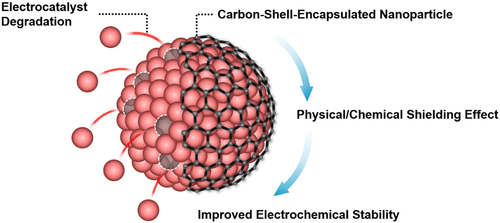当前位置:
X-MOL 学术
›
Acc. Chem. Res.
›
论文详情
Our official English website, www.x-mol.net, welcomes your feedback! (Note: you will need to create a separate account there.)
Carbon Shell on Active Nanocatalyst for Stable Electrocatalysis
Accounts of Chemical Research ( IF 18.3 ) Pub Date : 2022-04-18 , DOI: 10.1021/acs.accounts.1c00727 Ji Mun Yoo 1, 2 , Heejong Shin 1, 2 , Dong Young Chung 3 , Yung-Eun Sung 1, 2
Accounts of Chemical Research ( IF 18.3 ) Pub Date : 2022-04-18 , DOI: 10.1021/acs.accounts.1c00727 Ji Mun Yoo 1, 2 , Heejong Shin 1, 2 , Dong Young Chung 3 , Yung-Eun Sung 1, 2
Affiliation

|
Electrocatalysis is a key process for renewable energy conversion and fuel production in future energy systems. Various nanostructures have been investigated to optimize the electrocatalytic activity and realize efficient energy use. However, the long-term stability of electrocatalysts is also crucial for the sustainable and reliable operation of energy devices. Nanocatalysts are degraded by various processes during electrocatalysis, which causes critical performance loss. Recent operando analyses have revealed the mechanisms of electrocatalyst failure, and specific structures have been identified as robust against degradation. Nevertheless, achieving both high activity and robust stability with the same nanostructure is challenging because the structure–property relationships that affect activity and stability are different. The optimization of electrocatalysis is often limited by a large trade-off between activity and stability in catalyst structures. Therefore, it is essential to introduce functional structural units into catalyst design to achieve electrochemical stability while preserving high activity.
中文翻译:

用于稳定电催化的活性纳米催化剂上的碳壳
电催化是未来能源系统中可再生能源转化和燃料生产的关键过程。已经研究了各种纳米结构以优化电催化活性并实现高效的能源利用。然而,电催化剂的长期稳定性对于能源设备的可持续和可靠运行也至关重要。纳米催化剂在电催化过程中会被各种过程降解,从而导致严重的性能损失。最近的操作分析揭示了电催化剂失效的机制,并且已确定特定结构具有抗降解能力。然而,使用相同的纳米结构同时实现高活性和稳健的稳定性具有挑战性,因为影响活性和稳定性的结构-性质关系是不同的。电催化的优化通常受到催化剂结构的活性和稳定性之间的巨大权衡的限制。因此,必须在催化剂设计中引入功能结构单元以实现电化学稳定性,同时保持高活性。
更新日期:2022-04-18
中文翻译:

用于稳定电催化的活性纳米催化剂上的碳壳
电催化是未来能源系统中可再生能源转化和燃料生产的关键过程。已经研究了各种纳米结构以优化电催化活性并实现高效的能源利用。然而,电催化剂的长期稳定性对于能源设备的可持续和可靠运行也至关重要。纳米催化剂在电催化过程中会被各种过程降解,从而导致严重的性能损失。最近的操作分析揭示了电催化剂失效的机制,并且已确定特定结构具有抗降解能力。然而,使用相同的纳米结构同时实现高活性和稳健的稳定性具有挑战性,因为影响活性和稳定性的结构-性质关系是不同的。电催化的优化通常受到催化剂结构的活性和稳定性之间的巨大权衡的限制。因此,必须在催化剂设计中引入功能结构单元以实现电化学稳定性,同时保持高活性。


























 京公网安备 11010802027423号
京公网安备 11010802027423号